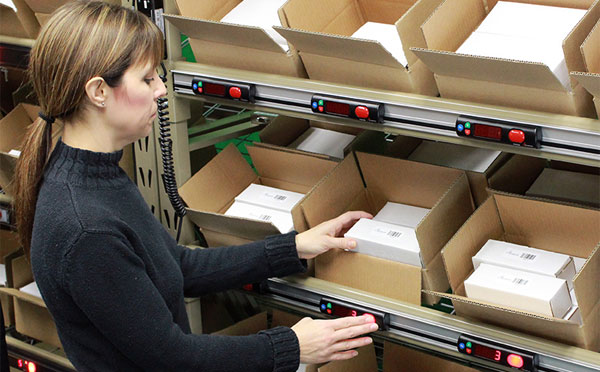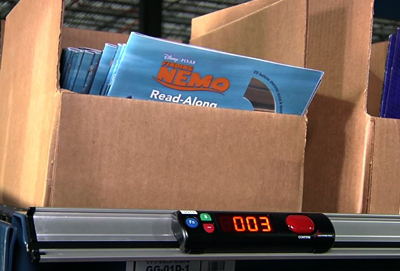10 Tips: Pick-to-Light Systems for Order Fulfillment
Light directed picking is the fastest operator-based order picking system - here are ways to implement it in your operation

Light-directed picking is the heavyweight champion when it comes to productivity gains, order picking speed, increased accuracy, and ease of operator development.
Because it’s 100% hands-free and requires no headpiece, it’s also highly flexible for many challenging fulfillment operations. We’ve compiled ten ways to analyze your operation to determine if these systems would be a fit for you. Obviously, more specific information will be needed, but this should get you started.
We spoke with Lightning Pick’s Dave Broadfoot about the best ways to ensure you are making a good pick-to-light decision.
1) Be sure your SKU volume is adequate to justify automation…
Light-directed systems don’t fit every operation, but for those with the right SKU volume, they’re ideal because they help eliminate errors, increase order picking speeds, and reduce training and development issues for new employees. How many is enough? That’s a question that sometimes depends on picking volumes. If you’re picking massive numbers of orders for a relatively small amount of SKUs, then picking systems are more justifiable.
“For example,” said Dave Broadfoot, Managing Partner at Lightning pick, “distribution centers with 6,000-plus SKUs with long aisles and pallet picks might look to alternative technologies such as RF pick, Voice Pick or a batch wave pick Put to Light system.
The Pareto principle is often helpful in these situations: if 20% of SKUs demand 80% of your order picking labor, consider a light-directed system.
2)…but remember you don’t need to automate an entire operation to enjoy the benefits
A common scenario is a partial automation targeted at specific goals – a single zone, a particular aisle, a group of work cells, etc. You can add pick-to-light in specific areas to increase productivity for your most critical, high-volume product picks or work zones.
“A mix of technologies can be used to address the order and SKU characteristics,” Broadfoot said. “Sometimes a fast mover area with pick to light is used with the order passing to another area and an RF technology is used to finish items to be picked.”
By taking advantage of using multiple technologies we eliminate the use of a paper pick and improve the real-time information available to track orders in the process.
The ability to evolve and adapt to new configurations or changing business should be top-of-mind for any order fulfillment upgrades you consider.

3) Don’t allow poorly-defined software integrations to cripple productivity gains
“If you have an existing WMS, WCS, or enterprise-level system” Broadfoot said, “A pick to light system can be integrated to take advantage of current investments in automation and fill further GAPS that can hinder optimal productivity”
4) Use light-directed picking to overcome challenges of a multilingual workforce and reduce learning curves for new or temporary workers
One of the best reasons to use pick-to-light is that the system is inherently simple, easy to learn and multilingual. Training people to use it is easier than it is to train a fast-food employee. This makes the learning curve slight and return-on-investment quick.
“Today’s fast-food technologies simplify each presentation process, making it easier for employees to learn it and excel at performing it,” Broadfoot added. Good automation should always reduce the training curve, allow employees to perform quickly, and in a variety of roles in an operation. Pick to light lets your order picking workforce adapt quickly to new or shifting roles.
Pick to light is also great for today’s multilingual labor force. You don’t have to worry about language skills, which is a concern with voice-directed or paper systems.
Also, when you have training or workforce turnaround problems, or use lots of temporary workers for spikes or to enhance your workforce, light picking is ideal due to its simplicity and ease of use for workers in a variety of picking situations.
5) Articulate your objectives: what do you really want from a directed picking system?
Companies use these systems mostly to increase picking speed and throughput, but there are other indicators that you should consider: labor cost reductions, accuracy, and as mentioned above, a reduction in training and onboarding issues. ROI is critical for these systems, so a comprehensive understanding of your goals is important. You won’t know everything you want to achieve from the word “go”, but you’ll be able to refine your objectives as the project moves forward. In one instance, a retail supplier of hardware reported a 300% jump in orders per day and a 35% productivity increase compared to its previous paper-based system. An example, the broad objective set might include:
- “Move our order accuracy from 98% to no less than 99.5%.”
- “Reduce mis-picks and our returns rate to less than .5%.”
- “Achieve at least 3,500 orders per day shipped.”
- “Reduce labor costs by 15%.”
These are just broad examples, and there of course must be more detailed goals backed up by an ROI analysis.
Broadfoot adds: “As a review of the fulfillment process is done there is also more hidden cost to consider. Consider paper-based picking the costs like pick sheet printing, delivery, and management. Then the issues with misplaced pick sheets and the information lag from picking to replenishing picked locations.”
These costs don’t necessarily show up in dollars and cents, but each manual transaction adds time and reduces efficiency.
6) Understand all your alternatives
Once you have decided to pursue an automation project, research your potential providers for experience, references, ability to integrate to other equipment and systems, etc.
There are plenty of ways to improve order fulfillment operations, and picking systems are just one. While choices are plentiful, it is difficult to understand how the application might be a good fit for your company without specific information. You should consider all of your alternatives — manual systems, light, voice and RF. Typically, pick to light is best for goods-to-person picking like carton flow, ASRS, carousels, and the like. Voice isn’t as suitable for those and should be used mostly for static storage like shelving and bins.
Light-directed systems aren’t sequential, like RF and voice terminals. With those systems, your computer system will dictate the picking order. Pick-to-light modules light activate for all pick locations simultaneously, which lets the operator pick her own path. That flexibility is believed to be superior to a more rigid system, since operators understand their picking area and can designate paths better, and in multiple directions.
Compare picking enhancements: Light-Directed vs. Pick to Voice vs. RF Systems.
7) Don’t automate bad processes
“You can’t automate bad processes,” one of our clients once told us as we dug into his project and he realized the scope of the challenges. It is a profound truth that no amount of automation will turn around a poor picking scheme or unworkable processes.
In fact, adding any type of automation is useless without a comprehensive understanding of how the new system will work and what processes it replaces or modifies. These projects are often fruitful for companies because they provide an opportunity to truly analyze the operation and what each department or work team is trying to achieve. That work alone can be invaluable, as you get a better understanding of your situation.
8) Is your picking scheme suitable to automated light assistance?
Most pick-to-light systems are zone picks. In a zone picking scheme, workers are assigned to an area where they will pick product to each passing order. Orders are typically conveyed, rolled on a cart, or perhaps an AGV or other transport method. It’s an assembly line approach that helps keep order pickers “home” in an area they know well, work daily, and can master quickly. Reduced walking means pickers aren’t as tired and commit fewer errors, while also wasting less time in transit to stock locations.
“Reduced walk time to pick locations results in higher pick productivity,” Broadfoot said. “Specialization and teamwork provides the optimal results in “Best in Class” order fulfillment and builds a more professional workforce.”
9) Don’t assume it’s out of your price range
Pick-to-light systems have been around since the 1980s in various forms and are used extensively and in many proven installations across a variety of industries. They have also seen costs decline the last five years or so, due to advances in technology and widespread computing. At one point, only very high-volume, large operations could afford this level of automation, but that’s not true today.
They’re installed in many midsize or smaller order fulfillment facilities and are generally considered tried-and-true technology.
10) Plan to use the data your pick-to-light system generates
One of the most useful things about automation is the data that it generates. Light-directed picking systems should provide real-time data that can help you understand a particular order picking employee’s productivity, speed and accuracy. It can also help you understand which types of orders and which products are problematic. This might help you re-slot, move a particular SKU into a light-directed zone, train employees, or redesign processes.
“The more information we have relating to a customer order the better decisions we can make relation to operation process, exception management and ultimately we can develop the best customer service which improves our customer relationships,” Broadfoot added.
What comes next?
As you move through the process, information must be gathered. We can assist you with these questions. The good news is that light picking systems can be specified with new facilities or fitted into existing goods-to-person picking options (flow racks, ASRS, carousels, etc), providing you a range of options as your company grows.
“In the end,” Broadfoot added, “the law of trade-offs” exists in every decision we make with a cost-benefit being applied to how the distribution center is developed. These decisions will constantly evolve as our customer expectations evolve. The journey to excellence in distribution will need end but can constantly improve making it a better place for employees and the ultimate customer.”
- Pick to light: an introduction
- Comparing pick to light, RF and voice-directed systems
- Light-directed putaway systems
- A quick guide to order picking methods and productivity rates
Video: an introduction to light-directed order fulfillment
Tags: 10 tips, ROI, Order Picking & Fulfillment, pick to light
Scott Stone is Cisco-Eagle's Vice President of Marketing with 35 years of experience in material handling, warehousing and industrial operations. His work is published in multiple industry journals an websites on a variety of warehousing topics. He writes about automation, warehousing, safety, manufacturing and other areas of concern for industrial operations and those who operate them.




